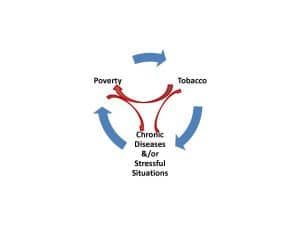The impact of war on the population’s mental health, including the refugees among them, is now established.
The most frequent mental disorders encountered are Acute Stress Disorder, depression, psychosomatic diseases (insomnia, chronic pain…) and Post Traumatic Stress Syndrome (PTSD).
In 2013, PTSD and Acute Stress Disorder have been introduced in the latest version of the Diagnostic and Statistical Manual of Mental Disorders (DSM V), as a new class of “Trauma and Stressor-related Disorders” with a common criterion, the exposure to a traumatic or stressful event (war, victim or actor of violence and crime, rapt, earthquake, fire etc.). The more the exposure to the traumatic event is severe and repetitive, the higher the incidence of mental disorders. For example, violent conflict is an important contributing factor to the development of mental illnesses, with 30-70% of people who have lived in conflict zones suffering from PTSD and depression.
However, if Acute Stress Disorder is the acute impact of the traumatic event and can be prevented by immediate psychological assistance, PTSD is its delayed consequence (until three years post-trauma), in addition to depression, anxiety, psychosomatic, development of behaviors (tobacco smoking, alcohol abuse, drug consumption, violence…) and suicide.
Moreover, in an article published recently in the American journal of addiction (Am J Addict. 2015 Nov 19. doi: 10.1111/ajad.12304), the authors concluded that people diagnosed with PTSD have higher rates of smoking and greater difficulty to quit, compared to the general population.
Thus, tobacco smoking is among the behavior that could be developed secondary to a traumatic event, and this is particularly true for vulnerable teenagers.
***
Smoking represents the biggest global public health issue. It is the first preventable cause of mortality, killing worldwide half of its consumers (6 million/year, including 600,000 passive smokers), and the principal risk factor of the non-transmissible chronic diseases (cause of 60% of total mortality). In addition, beside the many physical health pathologies (cancers, chronic obstructive pulmonary diseases, children’s asthma, sudden infant death, infertility…), new studies suggest that smoking might increase the risk of psychosis and schizophrenia.
According to the World Health Organization (WHO), more than 80% of smokers live in low- and middle-income countries. This is the case in the MENA region, where over 60% of adults are smokers. This explains why it is perceived as one of the prime targets of the tobacco industry, focusing in particular on the youth (as young as 14 years old), turning them into clients for life.
The situation can be summarized as shown below:

***
Since 2013, addiction to nicotine is classified in the DSM V according to the same clinical criteria as for the other types of addictions (alcohol, cannabis, drugs, sex, gambling…). Thus, tobacco smoking is a behavior.
To develop a behavior, three factors must be met:
- Addictive Substances must be available
- Individual vulnerability must be present, which could be genetic, psychological (traumatic event…) or psychiatric (mental diseases like bipolar, schizophrenia, depression…)
- Environmental factors, which could be familial (conflict and/or consumption) or social.
Unfortunately, all three factors could be easily met among teenage Syrian refugees.
Over the past decade, with the decrease of tobacco smoking in high-income countries, adolescents in the countries of the MENA region -including Syria- where laws are not always strictly enforced, and taxes are relatively low, are being the target of the tobacco industry. Which makes cigarettes cheap and easily available. Also, the tobacco industry found in illegal trafficking a way to flow out its excess production, which makes cigarettes even more affordable to the particularly disadvantaged population.
Half of the 12 million Syrians displaced (internally and across borders) since March 2011, are under the age of 18. Almost all of them have been exposed to traumatic events, either during the pre-migration period (violence, rapt…), the migration trip (hazards of travelling…) or in the post-migration period (low socio-economic status, low rate of school enrollment -between 20-30% only-, social integration, language barriers…), putting them at risk of a range of mental health issues, in particular PTSD: almost half of them have the delayed symptoms of this disease (ten times the prevalence among children around the world), and this prevalence is expected to increase over time for the next generations.
Add to that the already high rate of cigarette smoking among Syrian adult males (over 50%) and the cultural recrudescence use of Narguile (shisha, waterpipe), all those determinants make Syrian children and teenagers -in particular males- potential tobacco smokers.
As a result, Syrian refugees can be expected to present poor physical health, tobacco smoking being the most important factor of the preventable chronic diseases (Cardiovascular and cerebral diseases…), putting the health systems of the host countries at risk, increasing both their health expenditure and their poverty threshold. This is particularly important if smoking is associated with PTSD, making the success rate of quitting very low, with greater negative health effects.
Thus, being exposed to traumatic events and potentially developing PTSD, teenage asylum seekers are at higher risk of becoming tobacco smokers. Smoking is a behavior, and the addiction to cigarette is double, with dramatic physical and mental health impacts:
- Physical to the nicotine
- Psycho-behavioral to the action of smoking
But prevention is possible
It supposes a well defined strategy, a multi-disciplinary team work and a long-term follow-up. This implies close monitoring and accurate data collection. Also, screening for psychological and psychiatric issues among children should be an important chapter of the strategy, as tobacco smoking seems to be a stress coping strategy; instead, children should be initiated to positive ones (such as sport, art therapy…), in order to develop their resilience. Protective factors should also be developed such as social support and familial cohesion.
The tobacco industry will find a new market to develop its business, like it was cited in an article published in November 2015, (Smoking Syrian refugees could pick up Germany’s tobacco industry): “that the influx of refugees into Germany could boost the tobacco market (already an increase of 1% in the amount of sales has been noted) and that the preference for roll-ups and lower-end factory cigarettes could benefit companies like British American Tobacco and Imperial, who are strong in Germany.”
Two businesses are set to benefit from the migrant crisis: The tobacco industry, selling cigarettes (and/or E-cigarettes) to the displaced, and drug dealers, particularly those dealing with Captagon (amphetamine made in Syria). These will have obvious impact on the health of migrant populations. Are host countries preparing to address the side issues resulting from such behaviors? Do they have the means to break this vicious circle?
